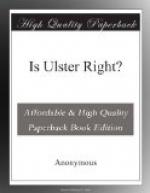“At Ring, in the County Waterford, there is already in existence an Irish secondary school where classics, modern languages and all the usual secondary school subjects are taught and where Irish and English fill their rightful places, the former being the ordinary language of the school, the latter a foreign language on no higher level than French or German.”
The Act of 1909, which founded the “National” University (to which I shall refer again), gave power to County Councils to levy a rate for scholarships. Immediately the Gaelic League saw their opportunity. They endeavoured to persuade the Councils to refuse to do so unless Irish were made compulsory at the University. The Councils generally (except of course in Ulster) agreed to the plan; but some of them (such as the Kildare Council) were faced by a difficulty. Not a single child in the county spoke Irish; and so if that language were made compulsory, no one could compete for the scholarships. So they compromised matters, by deciding that they would levy a rate if Irish were made compulsory after 1915, by which time some of the young people in the county would have been able to learn it; and the University agreed to do so.
This rating power, I may remark, looks extremely liberal as it appears in the Act; for the scholarships are to be tenable at any University. The Irish Unionist members, knowing quite well how it would be worked, opposed the clause; and as usual were denounced as bigots and fanatics. It is needless to add that as soon as the Act came into force, County Councils and Corporations at once passed resolutions that scholarships derived from the rates should not be tenable at Trinity College, Dublin, or at Belfast, but only at the National University—thus practically saying that no Protestants need compete.
Beyond forcing the children to acquire a smattering of Irish, it cannot be said that so far the efforts of the League as to the language have been very successful; for the census returns show that the proportion of the population who could speak Irish in 1891 was 14’5; in 1901, 14’4; and in 1911, 13’3; and the numbers who spoke Irish only fell from 20,953 in 1901 to 16,870 in 1911.
But the efforts of the League are not confined to the language. English games, such as cricket, are forbidden; if football is played, it must be the Gaelic variety with rules totally different from those observed by the hated Saxon. Even the patients in asylums are forbidden to play cricket or lawn tennis. And some of the more enthusiastic members of the League have actually “donned the saffron,” in imitation of the Ersefied Normans of 400 years ago. However, it is so hideously ugly, and so suggestive of the obnoxious Orange, that that phase of the movement is not likely to extend.
Even the “Boy Scout” movement has been made use of for the same object. As soon as some corps had been established in Ireland, the Nationalists started a rival organization with an Irish name, in which all the boys solemnly undertake to work for the independence of Ireland, and never to join England’s armed forces. The boys take a prominent part in the annual ceremonies in honour of Wolfe Tone, the Manchester martyrs, and other Nationalist heroes.




